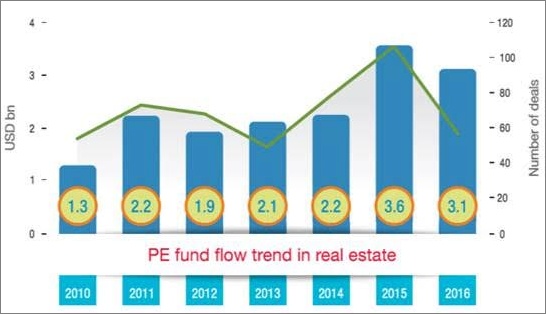Private equity now meets 75% of real estate sector fund needs in India: study
06 Apr 2017
The total fund flows to the Indian real estate sector has increased by 40 per cent to $5.4 billion in 2016, up from $3.8 billion in 2011. While this includes private equity, NBFC, bank credit and IPO, about three-fourth of all these investments come from PE funds, according to a study by Knight Frank.
Mumbai has regained its number one position in terms of attracting PE funds among all cities of India, while Bengaluru continues to hold steady in terms of attracting PE investments, although its share has dipped marginally since 2013.
About three-fourth of the real estate sector's funding requirement is met by PE players in the past couple of years as against one-fourth in 2010, according to a study by Knight Frank India.
''As the real estate market in India matures, driven by both regulatory and market forces, we expect PE capital to play an even greater role. Creation of public markets for commercial assets in the form of REITs and sale of distressed assets by banks to reduce NPAs are some of the drivers that would attract a lot of foreign capital into the Indian real estate market,'' said Rajeev Bairathi, executive director and head-capital markets at Knight Frank India.
The year 2015 witnessed the highest amount of PE fund flow in real estate since 2010 with more than $3.6 billion investments across more than 100 deals. The year 2016 saw a 13 per cent drop in PE fund flow with less than 60 deals in the previous year. However, the year 2016 recorded the highest amount of the average deal size, amounting to $56 million.
Shortages in quality retail space and increasing rental values have attracted PE players towards the retail segment in the last two years. Blackstone's purchase of L&T Realty's Seawood Mall and GIC's investment in Sheth Developer's Viviana Mall, are some of the large deals during the year.
''The current environment for real estate is both challenging and opportunistic at the same time. Bank credit, which used to account for anywhere between 50 per cent and 57 per cent of the sector's institutional funding requirement till 2014 has witnessed a sharp reduction in the last two years in the range of 24-26 per cent. Rising non-performing assets (NPAs), higher risk provisioning and mounting losses in the real estate industry have led to significant reduction in credit offered by banks. PE players have replaced banks and are currently the biggest source of institutional finance for the real estate industry. Currently, PE funding is not just restricted to equity but has largely moved towards a quasi-equity type of structure,'' said Samantak Das, chief economist and national director - research, Knight Frank India.
NCR, which used to lead in 2013, has dropped sharply from 39 per cent to just 9 per cent in a span of three years. Poor sales volume, huge amount of unsold inventory and stagnant prices in the residential segment of NCR have shifted PE investors interest away from this market.
IT Parks attract the largest deals within the real estate sector in India. With the average deal size amounting to $106 million. Some of the major deals during the year in the IT park space includes the $221 million fund raising by Manyata Promoters (part of the Embassy Group) from Edelweiss Financial Services and IIFL Holdings, and M3M's 3.5 mn sq ft Gurgaon IT park's stake sale to TRIL and Standard Chartered Private Equity.































